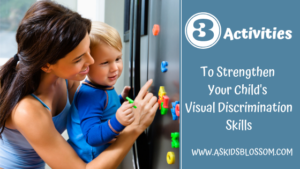
*This post contains affiliate links, meaning that, at no additional cost to you, I will earn a small commission if you click through and make a purchase.
If you have a child in preschool, you’ve likely heard or seen the term “visual discrimination”. Visual discrimination is one part of your child’s visual-motor skill development. Visual discrimination, essentially, is the ability to recognize smaller details in images.
This ability helps children to recognize and identify the color, size, and shape of objects, as well as their position. It is also the ability to observe the same and different between images. You’ve likely seen those puzzles where two similar pictures are side by side. You have to spot the differences- that takes visual discrimination skills!
Another way to think about visual discrimination is that it is the ability to pay attention to detail. I know that most parents of preschoolers would tell me that their children are WAY too busy to pay attention to detail, as many children this age are busy playing and moving from one activity to the next! It is definitely a skill that takes time to develop, but one that is very important.
Why Are Visual Discrimination Skills Important?
Visual discrimination is a foundational skill needed for reading. Children must be able to tell the difference between similar letters. Some examples are b and d, b and p, 5 and S. Younger children use visual discrimination as well- when matching socks, for example, or sorting similar toys. Problems with visual discrimination can have a big impact on your child’s learning down the road, if not addressed properly.
Luckily, there are several fun ways to practice visual discrimination. I promise, your child won’t even know that they are working on their skills as they do these activities!
Three Activities to Strengthen Visual Discrimination Skills
Cards.
Children seem to gravitate towards cards of any kind! I know that, in a pinch, I can hand my 4-year-old a deck of cards and keep him busy for 10 minutes or so while I get something done! With a bit of prompting, you can get your child sorting cards in no time, and building his visual discrimination skills as he does so! You can use a plain deck of cards, a deck of UNO cards, Old Maid cards, or really any type where the cards have differences. This set from Melissa and Doug has a variety of options! Some ways to sort: by color, by suit, or by number. For an older child, you can even have them sub-divide their piles. Once they sort between black and red, have them sort by suit.
Tangrams
Tangrams are a great toy to have in your toy rotation. There are a number of options to choose from, but I recommend a set like these, which have similar shapes of different sizes. This allows the child to sort all of the triangles, for example, and then split them into large and small. Children can also sort by color and shape. I recommend allowing your child time to play with the tangrams freely. You can ask them to do the sorting later on.
Magnetic Letters and Numbers
For a child that is beginning to recognize some letters and/or numbers, playing with magnetic letters and numbers is a fun way to practice visual discrimination skills. With a set of magnetic letters and a large cookie sheet, you can create a plethora of activities that help with visual discrimination. To start, put painters tape down the center of the tray. Have your child sort the letters and numbers.
There are many ways to sort, including letters/numbers, capital/lowercase, letters in the child’s name/letters NOT in the child’s name, and letters with curves and letters without.
When to Worry About Your Child’s Visual Discrimination Skills
For most children, visual discrimination develops easily and naturally. It’s common for many preschool-aged children to mix up left from right, and to confuse similar letters and numbers. If you are still seeing confusion in second grade or beyond, it’s likely time to see someone to get your child assessed.
With early intervention, problems with visual discrimination can be treated and improved. If you have concerns about your child’s development and would like to set up a free consultation to discuss your concerns, please reach out! I would love to help you determine your child’s individual needs. We are here to support you as you help your child blossom!
If you have tried any of these activities, or have other activity ideas of your own, please join us in our FREE Facebook community to share! We would love to have you.
If you liked reading Preschool Routines: How To Set Your Child Up For Success, you might also like:
Preschool Routines: Set Your Child Up For Success
Yoga for Kids: Benefits & Poses
